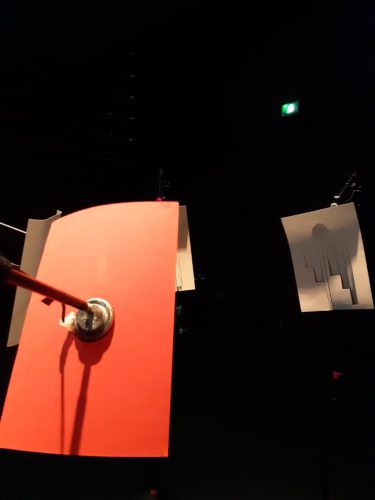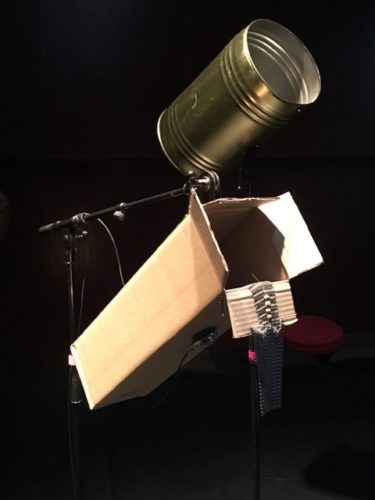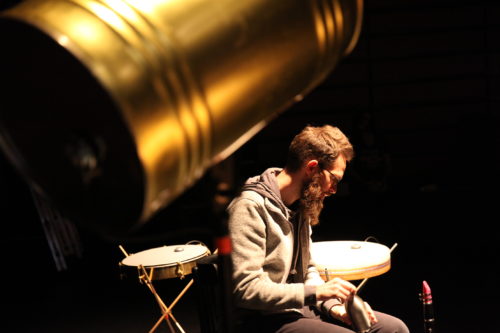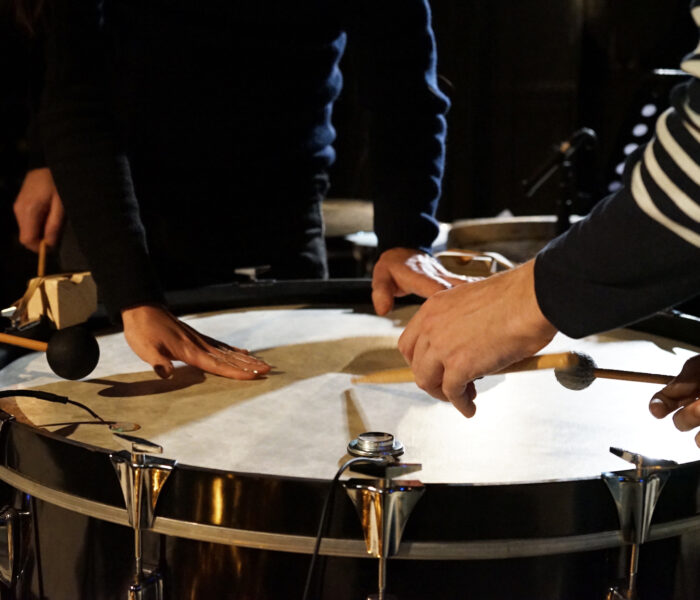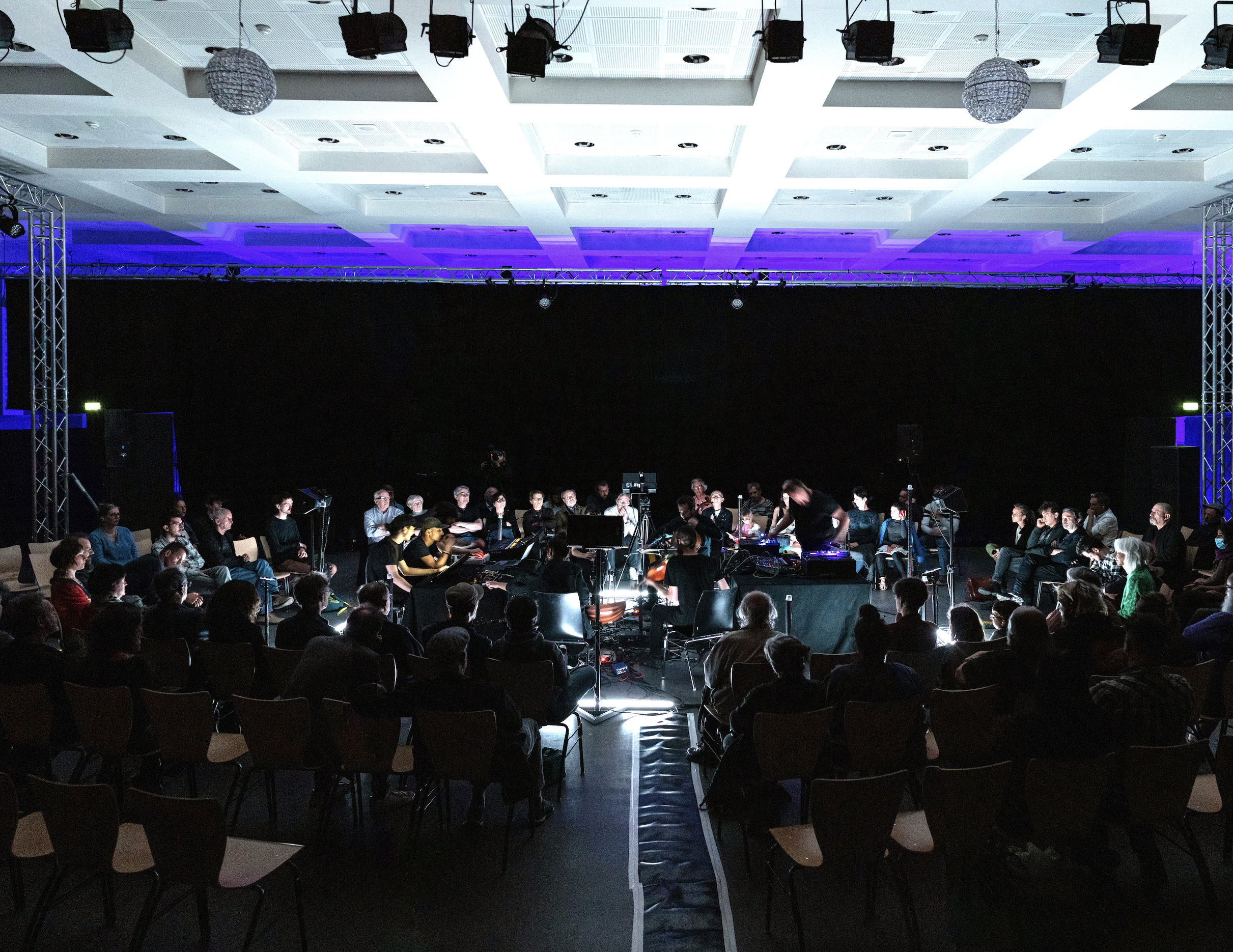« Prendre corps », d’Elsa Biston, présenté le 12 novembre au Théâtre de Vanves, s’offre d’abord sous les apparences d’une immersion sonore, pour très vite happer nos sens et nos consciences comme le ferait un rituel mystérieux.
Des coussins disposés au sol dans l’espace de la Panopée, une forêt d’objets photogéniques, incroyablement beaux dans leur simplicité, leur nudité (on pense à Dubuffet), reliés à des transducteurs (haut-parleurs), eux-mêmes reliés, on s’en doute, à un système informatique… et la compositrice, au milieu de ce dispositif, assise derrière son ordinateur, et qui, telle un démiurge, stimule cet orchestre d’objets avec un torrent de sons qui surgit sous ses doigts.
Voilà pour le tangible, le monde des apparences.
Et puisque la part visuelle de « Prendre corps » est primordiale, allons jusqu’au bout dans la description.
La forêt d’objets est en réalité une addition de petites clairières, de « choeurs », nous dit la compositrice. Pour ma part j’aime l’image de la forêt et des végétaux, car chaque objet est fixé sur une tige de métal inclinée et dont on imagine qu’elle pourrait se balancer, comme une fleur au vent : ici un choeur de feuilles de papier sculptées ou perforées, là un groupe de boîtes, de bidons, de plaques de métal, un ensemble de tambours…
Ces objets, dès le premier instant, en plus d’attirer nos regards nous « parlent ». Ils semblent en effet doués de parole, une parole nouvelle, une forme de langage du rêve, aux contours flous, un « bruissement de la langue » plus qu’une langue. C’est que les sons, envoyés par la compositrice depuis son clavier d’ordinateur, mettent ces objets en vibration, leur font « prendre corps », les « animent » donc. Voilà ces objets devenus des figures, des personnages qui nous tiennent compagnie. Ils font même plus que cela : en vibrant, en « parlant », ils réveillent en nous des histoires enfouies, des mondes oubliés.
Au début, le regard est si accaparé par la beauté des objets, les jeux de lumière et de vibration, que l’oreille suit le regard, est un peu à la traîne… Peu à peu pourtant le regard cède: les objets-personnages nous deviennent si familiers dans leurs caractéristiques physiques, leur matérialité, leurs capacité à vibrer, à murmurer, à chantonner, qu’ils deviennent une partie de nous. Nous sommes toute ouïe !
Nous oublions alors la démiurge – la compositrice – de la même manière qu’au Bunraku le spectateur, happé par l’action, oublie progressivement les mains des marionnettistes, qui actionnent les fascinantes silhouettes des personnages, promis à des destinées singulières. Nous entrons dans la musique, ou plutôt dans les textures, les jeux de plans que dessine cette musique polymorphe, dense, qui semble n’avoir ni début, ni fin, sorte de rêve éveillé musical, rythmé pourtant par quelques rappels de motifs, de sons, de vibrations, qu’on a l’impression de reconnaître mais qui à chaque fois se dérobent à notre mémoire, comme si un charme avait pris possession d’eux, car oui, « Prendre corps » a un côté « sorcier » !
« Sorcier » dans sa façon de tisser le naturel, l’animal (des chants d’oiseaux), le musical (sons d’orchestre, sons de voix, bribes de chansons), les sons de synthèse… « Sorcier » aussi dans les surgissements fantomatiques des deux clarinettistes Julien Pontvianne et Antonin-Tri Hoang, qui de temps à autre se déplacent dans l’espace du concert pour mêler leurs sonorités à celles des objets animés.
Quand surgit la fin de « Prendre corps », on n’est plus tout à fait les mêmes : nos yeux cherchent les objets-personnages devenus silencieux, alors que tout notre être vibre, des pieds à la tête.
« Prendre corps », assurément, nous emmène loin, et dessine une « cartographie » sonore à nulle autre pareille!
Pour en savoir plus sur « Prendre corps », discussion à bâtons rompus avec Elsa Biston.
Anne Montaron: Quand on entre dans la salle de spectacle, le regard est immédiatement attiré par les objets accrochés à tes tiges et reliés à des haut-parleurs : il y en a une vingtaine, divisés en cinq ou six groupes que tu appelles des choeurs je crois ?
Elsa Biston: Oui, car ils peuvent évoquer des personnages; on les a personnifiés. Des personnages qui sont parfois des humains, parfois des animaux, parfois des éléments naturels. J’avais envie de cette disposition qui les regroupe par famille et qui permet le voyage de l’élément naturel à la personnification.
Tu parles de personnification … en effet, on perçoit des voix, différents types de voix.
Oui, on a la sensation que ces objets nous parlent. Les voix, je les ai travaillées en amont. Il y a deux types de phénomène. Je pense par exemple à la boîte rouillée avec des pois chiches dedans, qui vibrent et zinguent. Quand on diffuse une voix enregistrée disons « proprement », on a l’impression qu’elle sort d’un vieux transistor.
D’autres fois, je les traite de façon à ce qu’on ait l’impression que ce soit l’objet qui émet cette voix. Comme le gros bidon doré, avec sa résonance grave et cuivrée qui émet des sortes de grognements.
Donc soit la voix est filtrée en amont, pour qu’il ne reste que cette composante-là, soit la transformation part d’un cri d’animal, ou d’un simple sinus, auquel j’ai donné une inflexion. Et tout ça se confond. On n’identifie pas l’origine des sons, et on a l’impression que c’est l’objet qui parle.
Peux-tu nous parler des sons que tu envoies dans les objets ?
J’envoie différents types de sons: des fréquences pures, plein de sinus qui font des battements et, parfois, des sortes de rythmes, et toute une matière sonore et vocale. Tout ça est composé. Il y a une timeline très précise. C’est la première couche de musique. La seule chose qui n’est pas « composée » ce sont les interventions des clarinettes, parfois fluctuantes. Chaque son est travaillé pour et avec l’objet qui le diffuse.
C’est un tout, un tissage: un son, pour un objet.
L’intervention des objets suit un scénario bien défini ?
Oui. En revanche, les sons changent beaucoup à la diffusion. J’ai beaucoup de couches encore à mixer in situ, car ce sont des objets artisanaux, et non des instruments fiables.
Je donne l’exemple du carton avec ses petites cottes de mailles qui frottent quand on envoie une vibration: ça fait des sons très bruités. Si on envoie les sons à un volume faible dans ce carton, il sonne seulement si je passe un certain seuil. Dans le cas du bidon, si je passe un certain seuil sur une fréquence donnée, il va se mettre en résonance et remplir toute la salle.
Il y a donc beaucoup d’incertitudes, en fonction de la taille de la salle, de la présence du public, de la température… Tout ça est à mixer au moment du concert. C’est presque de l’improvisation !
Le spectacle dure environ une heure: est-ce qu’il déroule une forme, une dramaturgie, ou bien ça se situe autre part ?
L’ensemble ne raconte pas une histoire. Je me situe à un endroit où l’on prend le temps d’entrer dans des situations. J’aimerais bien que l’auditeur s’interroge sur ses sensations et/ou associations d’idées : « comment se fait-il qu’un bidon génère pour moi ce type de souvenir, d’image ? » … La relation à l’objet est importante. Ces sons deviennent des personnages et interrogent. C’est un intermédiaire entre la musique acousmatique (qui est dans l’écoute pure) et la musique instrumentale (qui est incarnée). Ici on est entre les deux, du coup on se pose des questions sur la nature de l’écoute. Dans tout type de musique il y a des corps– qu’ils soient présents ou absents.
Pourquoi dans ce sens ajouter deux musiciens qui interagissent ?
Probablement pour interroger ce contraste-là et la distance entre les deux. D’ailleurs, ils sont à peine là, je les ai voulus presque fantomatiques : le minium de présence possible, et pourtant ça change tout! Quand je baisse le volume sonore et qu’ils jouent seulement en acoustique, ça crée un écart… et c’est important. J’aime leurs apparitions cycliques. Ils travaillent beaucoup par ailleurs sur les battements. Ils ont la maîtrise de ce battement. Leur recherche est très fine, ils mènent un travail sur le son très subtil.
Quel a été le point d’origine de cet orchestre d’objets ?
Le point de départ est un duo que j’avais avec Benjamin Sanz, qui est batteur de jazz. On cherchait un angle de travail et j’ai eu l’idée de poser des transducteurs sur sa batterie. La batterie m’a donnée envie de travailler autour des rythmes. D’où l’exploration des sinus et des battements. Cela produit des rythmes, qui semblent reconnaissables, mais comme on est dans le champ du continu, les contours des rythmes sont beaucoup plus flous, et les choses peuvent se promener. Le dispositif a grossi et je l’ai expérimenté sur un tas d’objets. J’ai vraiment l’impression d’avoir trouvé mon instrument, ça a été une sorte de révélation !
Tu as construit tous ces objets et ce dispositif toi-même. Et le choeur de plaques métalliques ?
J’ai travaillé avec un artiste qui s’appelle Stéphane Perraud. Avec lui, j’ai développé la face « installation » du projet. C’est lui qui a eu l’idée de ces plaques. Au début je travaillais sur des cymbales, avec tout un jeu de résonances. Quand on diffuse une voix dans ces plaques, ça la place dans un grand espace. La voix que je diffuse dedans, c’est la voix d’une habitante des quartiers du Haut-Montreuil que j’ai enregistrée pour un travail autrefois et qui me chante une berceuse pour enfants; ça me fait plaisir de lui donner cette place! (rire). Ce quelque-chose de solennel qui s’en dégage la valorise, d’une certaine façon.
L’humain interfère là aussi?
Oui, ce qui m’intéresse dans l’idée de « Prendre corps », c’est le fait que les voix circulent ou se répondent entre les différents objets ; c’est comme des flux d’idées qui deviennent « corps » par endroits ou qui flottent. Ces voix, ces sons restent toujours flous, pour que l’auditeur conscientise la part d’activité qu’il a dans la perception des choses. C’est l’auditeur qui se construit son histoire, ses fictions. C’est l’endroit où se situe mon travail.
Dans ma musique en général, je souhaite que l’auditeur suive son propre chemin. C’est une démarche à la Eliane Radigue ou Alvin Lucier… J’essaie d’être proche de situations sonores qui peuvent être des paysages, où il y a beaucoup des choses hétérogènes qui se superposent. L’oreille va chercher, décortiquer.
J’ai écouté du Charles Ives récemment : c’est incroyable comme sa démarche sort de la logique discursive de la musique occidentale. Il a été le premier à faire ça !
On est dans un espace qui est « géographique » puisqu’on peut l’explorer. Cette recherche m’a permis de m’extirper de réflexes de formes musicales. J’ai adoré cette expérience.
J’ai réalisé une chose : la musique évolue tout le temps, mais on n’est pas obligé d’avoir un discours qui va d’un point A à un point B… On peut revenir, repartir, installer un cycle, et traverser des étapes.
Article et propos recueillis par Anne Montaron



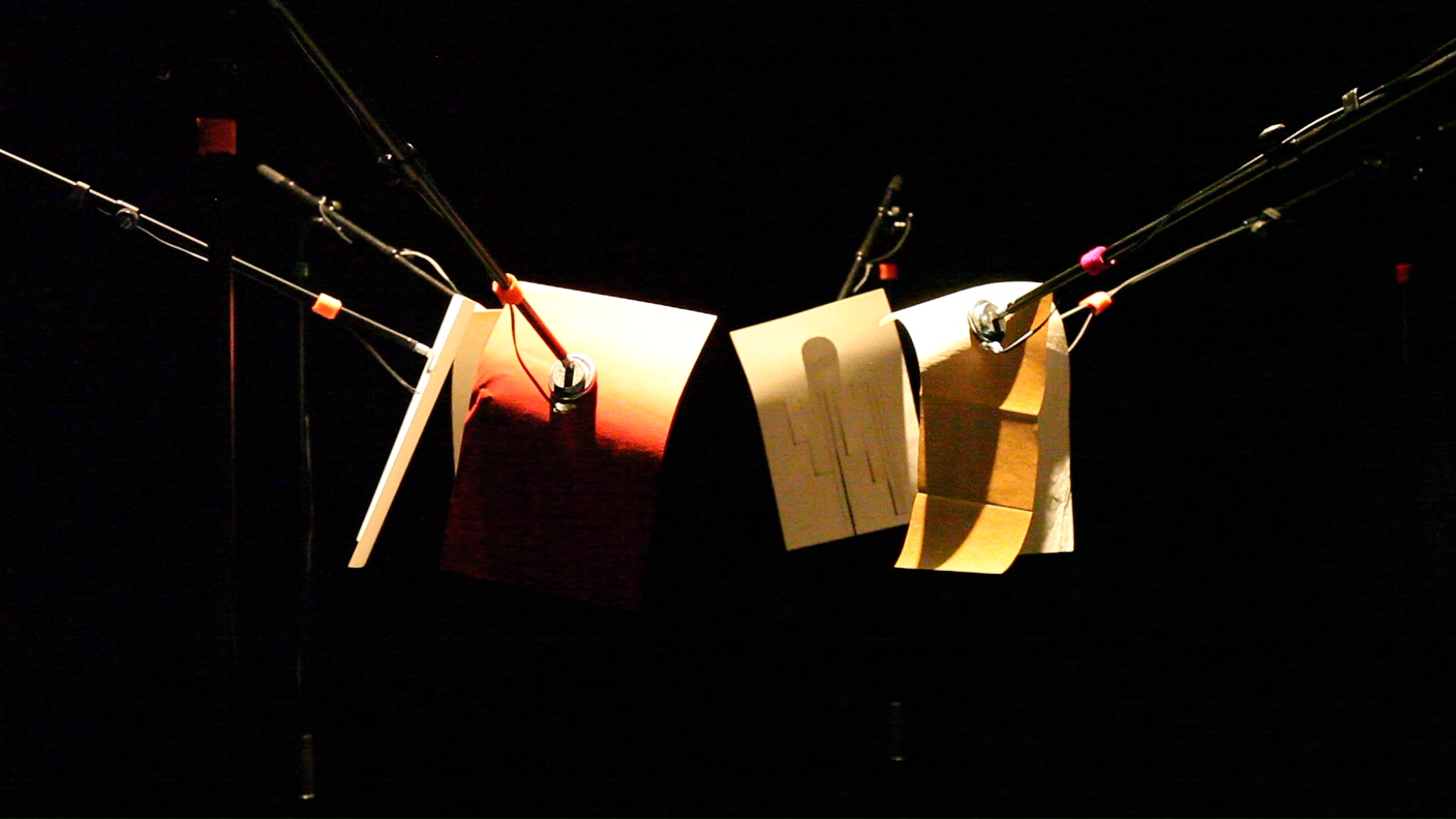)

